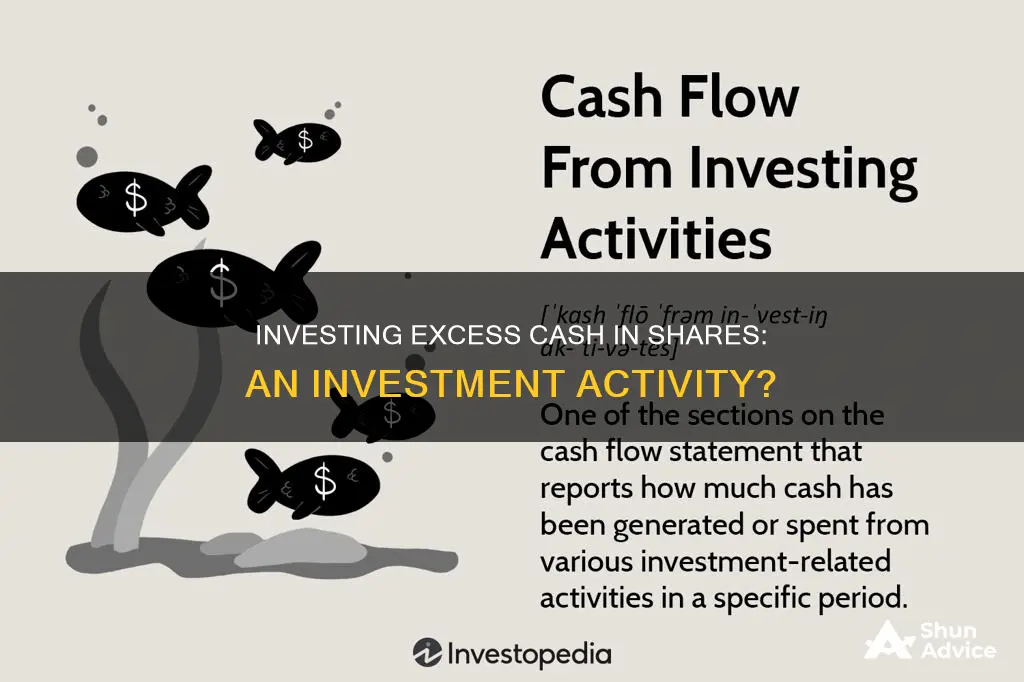
Investing excess cash in shares can be a great way to boost profit and generate income. However, it is important to understand the broader context of a company's financial health and goals when considering such investments. This includes analysing the company's cash flow statement, which provides insights into its investment performance and capital allocation decisions. The cash flow statement details the cash inflows and outflows from investing activities, such as the acquisition and disposal of long-term assets, investments in securities, and mergers or acquisitions. While investing excess cash can be beneficial, it is crucial to strike a balance between investing for growth and maintaining sufficient cash reserves to avoid missing out on investment opportunities or hindering financial viability.
What You'll Learn

Excess cash flow and repayment to lenders
Excess cash flow is a term used in loan agreements or bond indentures. It refers to the portion of a company's cash flow that must be repaid to a lender. It is typically cash received or generated by a company in the form of revenues or investments that trigger a payment to the lender as stipulated in their credit agreement.
Lenders impose restrictions on how excess cash can be spent to maintain control of the company's debt repayments. However, they must also ensure that these restrictions do not impede the company's financial standing or ability to grow. Lenders define what is considered excess cash flow, usually by a formula consisting of a percentage or amount above and beyond expected net income or profit over a certain period.
If a company raises additional capital through funding measures such as a stock issuance or debt offering, the company would likely be required to pay the lender the amount generated minus any expenses that occurred to generate the capital. Asset sales could also trigger a payment. For example, if a company sells investments or shares for a profit, the lender would likely require payment for those funds.
Excess cash flow is different from a company's free cash flow figure. Free cash flow is the cash left over after a company pays for its operating expenses and capital expenditures. It shows how efficient a company is at generating cash.
There are various financial products that can help individuals or companies manage their excess cash and potentially generate higher yields. These include brokered certificates of deposit (CDs), money market funds (MMFs), and government bonds such as Treasury bills ("T-bills").
Smart Ways to Generate Cash Flow with a $5000 Investment
You may want to see also

Investing activities in accounting
Investing activities can be broken down into two types of net cash activities: long-term assets and investments. Long-term assets include fixed assets such as real estate, vehicles, and machinery. Investments include cash paid to the principal amount of a loan held by a third party, cash equivalents, or trade securities held by the company.
- Capital expenditures: These are expenditures made towards the purchase of property, plant, and equipment (PP&E). PP&E expenditures are often referred to as "capital expenditures" and represent a significant investment for a company.
- Investment sales proceeds: When a company sells its PP&E or other capital assets, these proceeds count as investing activities. Even if the sale is at a discounted price, causing a loss for the company, it still increases the cash flow amount in the investing activities section of the SCF.
- Fixed asset purchases: Companies often acquire fixed assets using credit rather than cash. Examples include acquiring another business, a fleet of vehicles, or land for future properties. Payments made towards these fixed assets will appear as a decrease in cash flow in the investing activities section.
- Fixed asset sale proceeds: The sale of a fixed asset, such as another business, property, vehicles, or equipment, is considered divestiture. Any proceeds from such sales are recorded as investing activity cash received in the balance sheet.
- Purchase of marketable securities: This includes the purchase of stocks, bonds, or other investment instruments. While these purchases decrease cash flow, they represent the potential for future growth and positive cash flow through dividends or increased company value.
- Sale of marketable securities: The sale of investment securities can generate positive cash flow for a company.
The cash flow from investing activities is an important metric for understanding a company's financial health and growth prospects. It provides insights into the company's capital expenditure and investment strategies, helping stakeholders assess its ability to invest in growth opportunities, acquire assets, and manage its long-term financial health.
Converting Folio Investments: Strategies for Liquidating Your Portfolio
You may want to see also

Calculating excess cash flow
Excess cash flow is a term used in restrictive covenants in loan agreements or bond indentures. It refers to the cash held by a company that can trigger a mandatory repayment of debt.
Let's say a company spent $30 billion on capital expenditures, $5 billion on investments, and $1 billion on acquisitions. They also realized a positive inflow of $3 billion from the sale of investments. To calculate the excess cash flow, we sum up these amounts:
Excess Cash Flow = $30 billion + $5 billion + $1 billion - $3 billion = $33 billion
So, the excess cash flow for this company is $33 billion.
It's important to note that the calculation of excess cash flow can vary depending on contract terms, as certain expenditures may be excluded. It is different from the concept of free cash flow, which refers to the cash left after deducting operating expenses and capital expenditures.
Maximizing Your Spare Cash: Smart Investing Strategies
You may want to see also

Investing in stocks and bonds
Investing excess cash in shares is an investing activity. Here are some insights on investing in stocks and bonds:
Stocks
Stocks are a type of security that represents ownership in a company. When you buy a share of stock, you essentially own a small portion of that company. The value of your shares can increase over time as the company's performance and profits improve, but it can also decline if the company's performance declines. Stocks offer the potential for higher returns compared to other investments, but they also come with higher risks. It's important to diversify your stock portfolio by investing in multiple companies, industries, and types of stocks to mitigate risk.
There are several types of stocks, including growth stocks, value stocks, income or high-dividend stocks, and blue-chip stocks. Growth stocks are often found in new or growing industries with potential for earnings to increase faster than the market average. Value stocks are undervalued stocks of companies with good earnings. Income stocks usually pay steady dividends but may not experience significant share price growth. Blue-chip stocks are stocks of large, well-regarded companies with a strong history of performance and often pay dividends.
Bonds
Bonds are a type of security that represents a loan to the issuer, typically a company or government agency. When you invest in bonds, you are lending money to the issuer in exchange for interest payments. Bonds have a maturity date when the loan is due to be repaid in full. They tend to have more stable returns than stocks and are considered a more conservative investment option.
There are different types of bonds, including corporate bonds, investment-grade bonds, high-yield bonds, municipal bonds, and government bonds. Corporate bonds are issued by private corporations and can be redeemed by a fixed date. Investment-grade bonds have lower interest rates and higher credit ratings. High-yield bonds have lower credit ratings and offer higher interest rates due to a higher risk of default. Municipal bonds are issued by states, counties, or municipalities and are usually exempt from federal income tax. Government bonds, such as US Treasury notes, are backed by the government and considered a lower-risk investment.
When investing in stocks and bonds, it's important to consider your risk tolerance, investment goals, and time horizon. Stocks typically offer higher potential returns but come with higher risks, while bonds provide more stable returns and are considered less risky. By investing in both stocks and bonds using an asset allocation strategy, investors can aim to take advantage of rising markets while limiting losses during downturns.
It's also important to diversify your portfolio by investing in different types of stocks and bonds, as well as other investment options such as mutual funds, index funds, or exchange-traded funds (ETFs). This diversification can provide a healthy mix of assets and add stability to your portfolio.
Understanding Investment Impacts on Cash Flow Statements
You may want to see also

Investing in money market funds
Money market funds are a type of mutual fund that invests in short-term, high-quality, and low-risk securities. They are designed to provide high liquidity, stability of capital, and higher yields than some other cash products. Money market funds are insured by the Securities Investor Protection Corporation (SIPC) and are not covered by the FDIC.
There are several types of money market funds, including:
- Prime Money Funds: These funds invest in high-quality, short-term money market securities issued by U.S. and foreign entities, including corporations, financial institutions, and the U.S. government.
- Government and Treasury Money Funds: These funds invest in short-term U.S. government debt securities, such as Treasury bills, bonds, and notes.
- Municipal Money Funds: These funds invest in short-term municipal money market securities issued by states, local governments, and other municipal agencies. The interest earned on these funds is typically exempt from federal income tax and, in some cases, state income taxes.
Money market funds can be purchased through investment fund companies, brokerage firms, and banks. They are a safe and liquid investment option for investors, offering a diversified and professionally managed portfolio. However, they are not suitable for long-term investment goals, as they offer little capital appreciation.
Cash Outflow for Land Purchase: Investing Activity?
You may want to see also
Frequently asked questions
Excess cash flow is a term used in loan agreements or bond indentures that refers to the portion of a company's cash flow that must be repaid to a lender. It is usually cash generated by the company in the form of revenues or investments that trigger a payment to the lender as stipulated in their credit agreement.
A growing reserve of cash typically signals strong company performance. It could mean that the company is generating strong revenues and that cash is accumulating faster than management can figure out how to use it. This is often the case for highly successful firms in sectors like software, services, entertainment, and media.
If cash is a permanent fixture on a company's balance sheet, it could mean that management has run out of investment opportunities or lacks the foresight to allocate it effectively. Sitting on cash can be expensive because it has an opportunity cost, which is the difference between the interest earned on holding cash and the price paid for having that cash, as measured by the company's cost of capital.
Investing activities are a section of a company's cash flow statement that details how much money has been used or generated from making investments during a specific time period. This includes purchases of long-term assets (such as property, plants, and equipment), acquisitions of other businesses, and investments in marketable securities (stocks and bonds).
Investing activities can include the purchase or sale of property, plants, and equipment (PP&E), also known as capital expenditures. They can also include the acquisition or sale of other businesses, as well as the purchase or sale of marketable securities such as stocks, bonds, debentures, or other investments.







